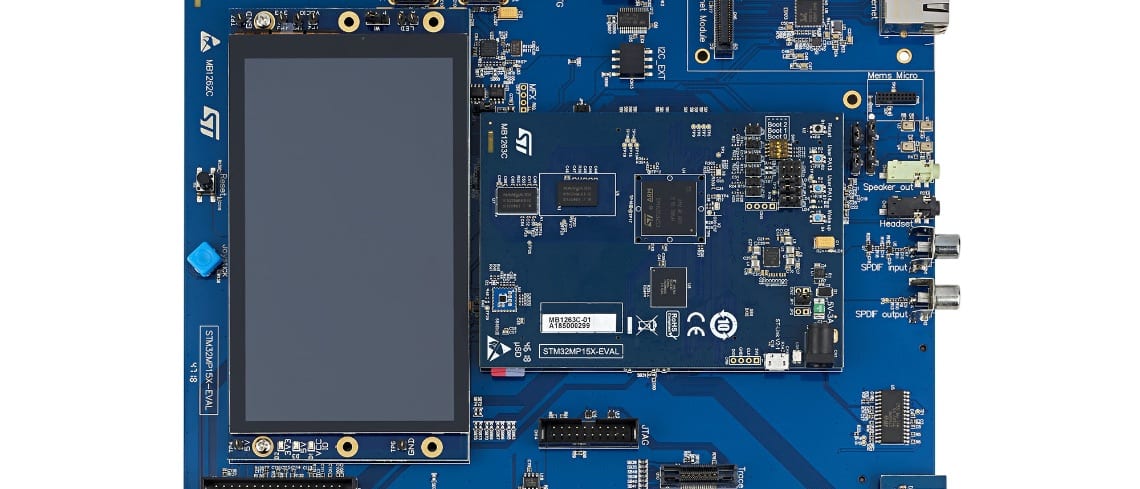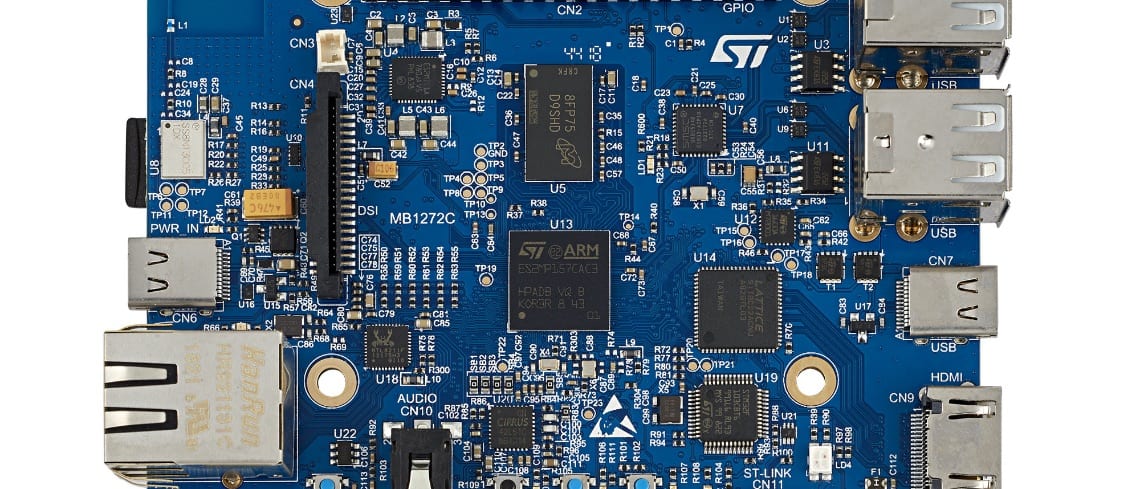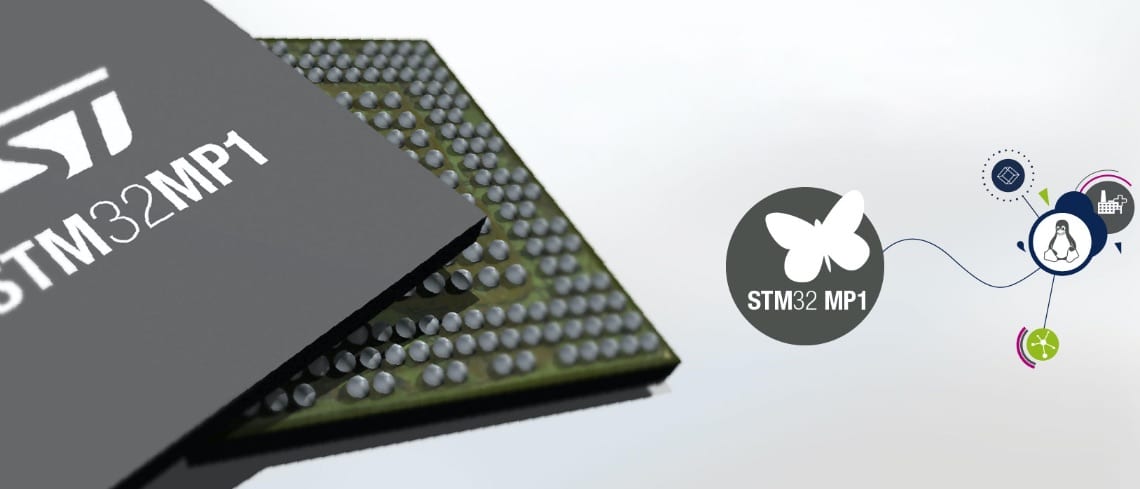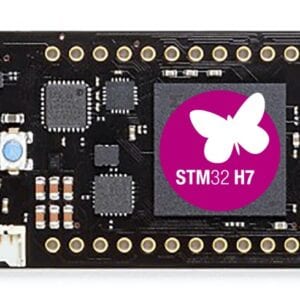We are announcing the release of new STM32MP1s with a frequency of 800 MHz as part of our desire to continue the expansion of our MPU’s catalog. A year after the launch of the STM32MP1, which is our first STM32 microprocessor and our first heterogeneous system architecture (HSA), the new models are highly promising because they capture the work we put in 2019 to make MPUs more accessible and practical. Indeed, not only are the latest components more powerful, but they also adopt industrial qualifications with a 100% duty cycle and temperatures ranging from -40 ºC to 125 ºC for 24/7 applications. It means that our family of MPUs will be able to reach more teams as well as thrive under harsher conditions, opening the door to more use cases.
However, focusing only on the hardware specification would be a mistake because, behind the scenes, the STM32 Team also increased the pertinence of the STM32MP1 by creating more partnerships, convincing more customers, improving tools, and training more engineers. We held STM32MP1 workshops to help accelerate the development of applications and partners like byte at work, and to ensure that teams could get their MPU design to market faster. We thus decided to look at our experience during the first year of our MPU and share the Ten Commandments designers and decision-makers should keep in mind as they start a project (first four commandments) and as work toward a successful launch (last six commandments). This list aims to help companies that are transitioning from an MCU to an MPU or to demonstrate traditional MPU customers that we can provide a vertical solution to satisfy their needs.
1. You Shall Not Undervalue the Importance of Your Software
Many companies that traditionally work with MCUs learn that they must adapt their priorities to benefit from all the advantages of MPUs. Traditionally, a team using an MPU spends about 60% to 80% of their investments on the software, while a microcontroller will often require a more hardware-centric approach. The different technical MPU model leads to a different business model that enables the use of the same code base through various platforms and thus better amortization. Even after finalizing the hardware, the work that takes place on the software side is still fundamental and requires maintenance as well as updates. However, the advantage is that the software can more easily run on other hardware platforms, and teams can reuse it much more easily.
2. You Shall Not Forget Your Software
Software plays such a crucial role when working on a product with an MPU, and it’s so much easier to reuse the codebase on other platforms, that it dramatically impacts the economic models. For instance, it makes a lot more sense for companies that design around an STM32MP1 to focus on the software and launch their products quickly while also planning to optimize it. Companies that work with an MPU update their applications quickly because the returns are outstanding. When a team is first to launch a product and then rapidly optimizes it, it can more rapidly lower costs and improve the user’s experience, among many other things. Engineers must thus plan roadmaps that take quick updates into account.
3. You Shall Not Underestimate Your PCB Design
When designing the PCB for a microcontroller, teams often need to deal with four to six layers, and although coming with a custom design is far from easy, it’s also very feasible. On the other hand, a PCB for an MPU is far more complex. Teams very often end up with ten layers or more, they need to contend with sophisticated power management ICs and deal with high-speed external RAM which is extremely difficult. Indeed, sampling DDR modules and handling up to 32 signals in parallel, with all the difficulties that it entails, will be a serious challenge, even for the most seasoned engineers.
ST does offer a DDR Tool to automatically output specific configuration parameters as part of our efforts to make MPUs as accessible as possible and we work with System-on-Module (SoM) as well as System-in-Package (SiP) partners to ensure engineers get efficient help to solve this matter. Engineers coming from the MCU world must understand that MPU PCB design is a very different beast. The STM32MP1 can help reduce the PCB cost, though, thanks to its 0.5 mm / 0.8 mm pitch that can lead to a reduction of the number of PCB layers by avoiding vias.
4. Remember Your Engineers and What They Need to Do a Good Job

Decision-makers ought to understand that there’s a lot more to an MPU than hardware specifications and that the utilities from the manufacturer, the documentation, and the community that rallies around a component are also crucial to the success of a project. ST updated STM32CubeMX, STM32CubeProgrammer, and STM32CubeIDE during 2019 to ensure that developers could use these familiar utilities to create applications for the STM32MP1. Moreover, we also have a comprehensive Wiki that our customers have found truly valuable. The proper documentation, the right community, and adequate tools can make the difference between accomplishment and frustration. As a result, companies need to choose an MPU from a manufacturer that offers a lot more than just datasheets.
5. You Shall Not Dismiss Your SoM or SiP Partners
One of the distinctive advantages of the STM32MP1 is its adoption by System-on-Module and System-in-Package partners that can offer great development solutions. We saw how bytes at work could help teams get to market faster, but many organizations coming from the MCU world can sometimes dismiss those services too quickly, thinking they’ll save money if they handle design operations in-house. However, designing a SOM-like implementation, with its complex PCB design due to the DDR tuning necessary and its adaptation of the Board Support Package, may require between four to six engineers for at least four to six months. This operation can easily drive costs up, not counting the related qualification and production expenses.
Some teams may be reluctant to go through a SoM or SiP partner because of a perceived initial cost. However, in most cases, paying a company to handle the inherent hardware complexities of MPUs will offer a much greater return than doing a PCB and Board Support Package design from scratch. Some will choose a System-on-Module because it offers more technical flexibility and facilitates local support, especially when volumes justify it. Others will select a System-in-Package because it tends to fit more space-constrained environments. In both cases, they can drive the costs of a PCB implementation down and allow for four-layer designs. Hence, using a SiP or a SoM will enable teams to focus on the software and unique features, which should be a top priority.
6. You Shall Not Delay Your Release

One of the biggest traps companies can fall into is perpetually delaying their product launch. The impact of a late release is often more catastrophic than what people anticipate. Habitually, delays happen when teams don’t keep one of the previous commandments in mind or are reluctant to invest in their project properly. The initial cost of using an MPU can sometimes be higher than when integrating an MCU, but being first on the market to offer a new solution to customers is far more important. Moreover, because it’s a lot easier to reuse software, even when tweaking hardware platforms, it’s also simpler to continue updating the design to build a user base and more rapidly get a return on that investment by quickly following an initial launch with significant hardware and software updates. Timelines may be stricter and more grueling, but the payoff can also be more immediate.
7. You Shall Not Ignore the Linux Community
Too often, companies underestimate the importance of the Linux distribution they will use when working on a project with an MPU. Yet, the operating system is crucial, which is why we offer the OpenSTLinux distribution that answers a vast number of development and engineering needs, thanks in part to the availability of three packages aimed at various use cases. Using Linux also opens engineers to its vast community and it makes porting application a lot easier. In 2019, we also inaugurated an STM32MPU distribution for Android to enable developers to quickly develop additional applications for the mobile OS, which will ensure that those who are familiar with this platform save a lot of time.
We also distinguish ourselves by our contributions to the Linux community, and we guarantee extensive kernel support. The Linux community validated all our drivers and we support projects like Yocto that facilitate the use of Linux on embedded systems. Additionally, we support two Linux kernels simultaneously. While the current Long-Term Support version still gets fixes and patches, we’ll support the next LTS current with upgrades and fixes. It means each LTS kernel gets two-year support so companies can update the kernel of their OS without worrying about security flaws or a lack of support if bugs arise.
8. You Shall Not Abandon Your Sense of Community
Success with an MPU often depends on how smart teams work, and one of the best ways to be efficient is to collaborate with experts. As a result, a good MPU maker must have a lot of partners to assist engineers in their various tasks. During 2019, ST increased the number of its Authorized Partners from eight to 27, and the ST Partner Program is full of teams that will assist designers working on an STM32MP1. For instance, some of our partners offer modules to hasten the hardware development phase, while others will greatly facilitate the creation of a graphical user interface running on our MPU, and some will offer engineering services and training. Any manager considering an MPU must evaluate the quality of the community that rallies around it, such as the growing number of ST Partner that work with and around our MPU.
9. You Shall Not Bury Your Head in the Sand

As we looked at what to expect in 2020, we saw that the increasing popularity of screens is changing the industry. Even the simplest white goods or industrial systems are starting to have a display and possibly a touch interface. GUIs in embedded systems are now more common than ever. And with the rise of machine learning at the edge, users expect more from their connected products. Microprocessors for smaller systems are nothing new, but as products demand more power for graphics and artificial intelligence, while still keeping the power consumption low, teams must consider the use of an MPU instead.
One of the distinguishing features of the STM32MP1 is its 3D graphics IP that can enable the creation of systems with smooth, complex, and valuable graphical environments for human-machine interfaces (HMI) applications. Employing the help of one of our partners that specializes in designing user interfaces can make this process even more straightforward and rewarding to engineers as well as satisfying to end-users.
10. You Shall Not Renounce Your MCU Origins
Some companies have worked with microcontrollers for decades and dread moving to MPUs because they are so foreign from what they know. One of the fundamental advantages of the STM32MP1 is that it doesn’t ask its adopters to renounce the MCU world. Thanks to its Cortex-M4, it can run an RTOS, and teams can reuse the motor control applications, connectivity shields, or their Fast Fourier transform algorithms that they already run on other MCUs. They get to enjoy the increase in computational throughput, the DDR memory, and the Linux environment, while also running the applications they normally would run on an MCU, making the transition to MPUs that much smoother. Indeed, the fastest way to go where we wish to go is to remember where we came from.




